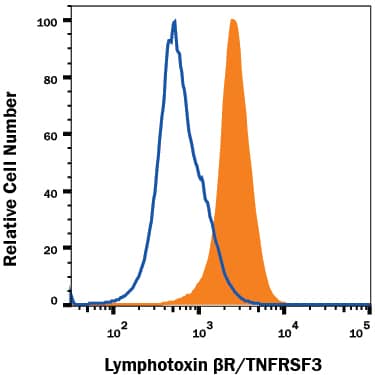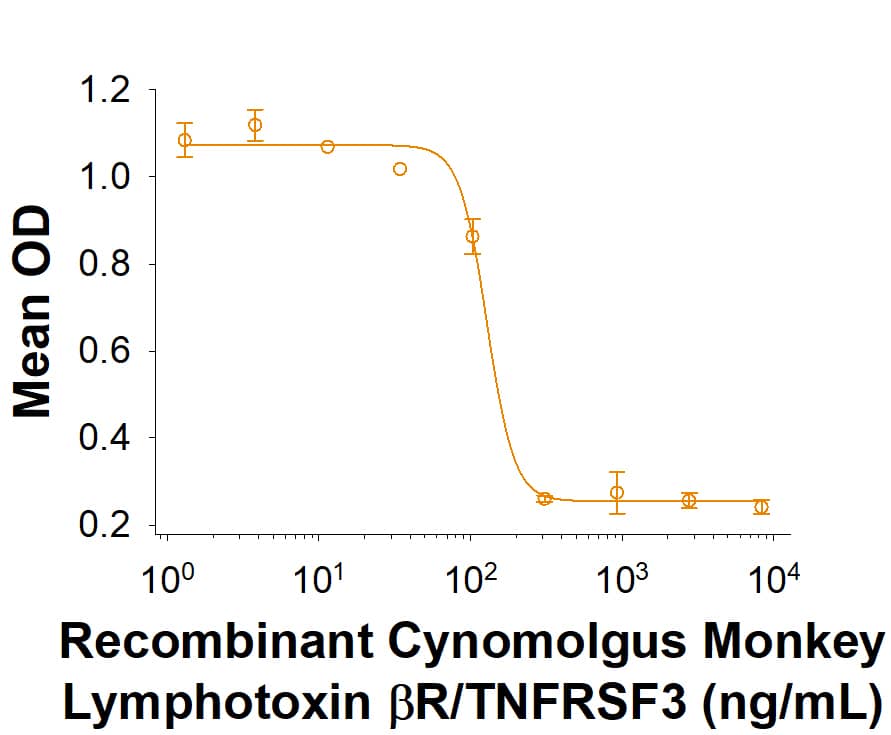Lymphotoxin beta R/TNFRSF3 Products
Lymphotoxin beta receptor (LTbR), also known as TNFRSF3, TNF RIII, and TNF Rrp, is a transmembrane receptor for the homotrimeric LIGHT/TNFSF14 and the heterotrimeric LTalpha1/beta2. LTbR engagement induces the production of IL-7, RANK, TRANCE/RANK L, VEGF-C, the adhesion molecules VCAM-1, ICAM-1, and MAdCAM, and the chemokines CXCL13, CCL19 and CCL21.
LTbR is expressed on mesenchymal stromal organizing cells that give rise to stroma of primary (thymus), secondary (tonsils, lymph nodes, and Peyers patches) and tertiary (ectopic inflammatory) lymphoid structures. It is expressed by hepatocytes and is upregulated in regeneration, hepatitis, and hepatocellular carcinoma where it regulates lipid metabolismd. A soluble form of LTbR can be released and functions an inhibitor of transmembrane LTbR.
Products:
180 results for "Lymphotoxin beta R/TNFRSF3" in Products
180 results for "Lymphotoxin beta R/TNFRSF3" in Products
Lymphotoxin beta R/TNFRSF3 Products
Lymphotoxin beta receptor (LTbR), also known as TNFRSF3, TNF RIII, and TNF Rrp, is a transmembrane receptor for the homotrimeric LIGHT/TNFSF14 and the heterotrimeric LTalpha1/beta2. LTbR engagement induces the production of IL-7, RANK, TRANCE/RANK L, VEGF-C, the adhesion molecules VCAM-1, ICAM-1, and MAdCAM, and the chemokines CXCL13, CCL19 and CCL21.
LTbR is expressed on mesenchymal stromal organizing cells that give rise to stroma of primary (thymus), secondary (tonsils, lymph nodes, and Peyers patches) and tertiary (ectopic inflammatory) lymphoid structures. It is expressed by hepatocytes and is upregulated in regeneration, hepatitis, and hepatocellular carcinoma where it regulates lipid metabolismd. A soluble form of LTbR can be released and functions an inhibitor of transmembrane LTbR.
Products:
| Source: | NS0 |
| Accession #: | P50284 |
| Applications: | BA |
| Reactivity: | Mouse |
| Details: | Goat IgG Polyclonal |
| Applications: | WB, Flow, IHC, CyTOF-ready |
| Reactivity: | Mouse |
| Details: | Rat IgG2a Monoclonal Clone #157108 |
| Applications: | Flow |
| Source: | CHO |
| Accession #: | XP_005569951.1 |
| Applications: | BA |
Cynomolgus Monkey His-tag
| Source: | CHO |
| Accession #: | XP_005569951.1 |
| Applications: | BA |
| Source: | NS0 |
| Accession #: | NP_001008316 |
| Applications: | BA |
| Reactivity: | Human |
| Details: | Mouse IgG1 Monoclonal Clone #MM0461-3T24 |
| Applications: | WB, Flow, CyTOF-ready |
| Reactivity: | Mouse |
| Details: | Rat IgG2a Monoclonal Clone #157108 |
| Applications: | Flow |
| Reactivity: | Human |
| Details: | Mouse IgG1 Monoclonal Clone #71319 |
| Applications: | Flow |
| Reactivity: | Human |
| Details: | Mouse IgG1 Monoclonal Clone #71319 |
| Applications: | Flow |
| Reactivity: | Mouse |
| Details: | Rat IgG2a Monoclonal Clone #157108 |
| Applications: | Flow |
| Reactivity: | Mouse |
| Details: | Rat IgG2a Monoclonal Clone #157108 |
| Applications: | Flow |
| Reactivity: | Human |
| Details: | Mouse IgG1 Monoclonal Clone #71319 |
| Applications: | Flow |
| Reactivity: | Human |
| Details: | Mouse IgG1 Monoclonal Clone #71319 |
| Applications: | Flow |
| Reactivity: | Human |
| Details: | Mouse IgG1 Monoclonal Clone #71319 |
| Applications: | Flow |
| Reactivity: | Human |
| Details: | Mouse IgG1 Monoclonal Clone #71319 |
| Applications: | Flow |
| Reactivity: | Mouse |
| Details: | Rat IgG2a Monoclonal Clone #157108 |
| Applications: | Flow |
| Reactivity: | Mouse |
| Details: | Rat IgG2a Monoclonal Clone #157108 |
| Applications: | Flow |
| Reactivity: | Human |
| Details: | Mouse IgG1 Monoclonal Clone #71319 |
| Applications: | Flow |
| Reactivity: | Mouse |
| Details: | Rat IgG2a Monoclonal Clone #157108 |
| Applications: | Flow |
| Reactivity: | Human |
| Details: | Rabbit IgG Polyclonal |
| Applications: | ICC/IF |
| Applications: | ELISA |







![Immunocytochemistry/ Immunofluorescence: Lymphotoxin beta R/TNFRSF3 Antibody [NBP2-68777] Immunocytochemistry/ Immunofluorescence: Lymphotoxin beta R/TNFRSF3 Antibody [NBP2-68777]](https://resources.bio-techne.com/images/products/Lymphotoxin-beta-R-TNFRSF3-Antibody-Immunocytochemistry-Immunofluorescence-NBP2-68777-img0001.jpg)
![ELISA: Human Lymphotoxin beta R/TNFRSF3 ELISA Kit (Colorimetric) [NBP3-40046] Human Lymphotoxin beta R/TNFRSF3 ELISA Kit (Colorimetric)](https://resources.bio-techne.com/images/products/nbp3-40046_human-lymphotoxin-beta-r-tnfrsf3-elisa-kit-colorimetric-21102024152825.png)